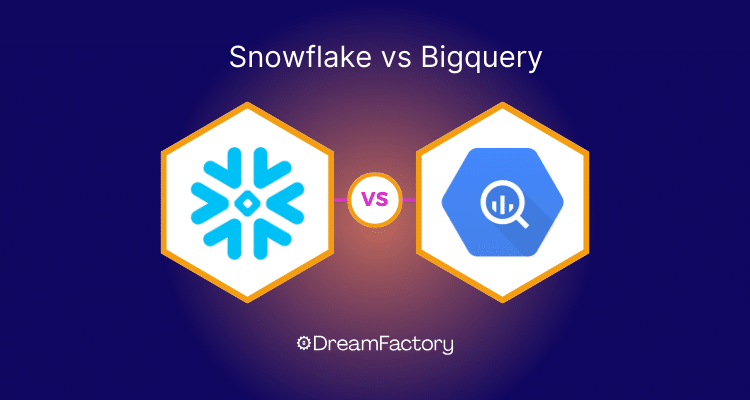Snowflake vs BigQuery | Key Differences & How to Choose
by Spencer Nguyen • February 27, 2024

When it comes to cloud data warehousing, the choice between Snowflake vs BigQuery is crucial for businesses that rely on big data analytics for decision-making. Snowflake, known for its flexibility and ease of use, contrasts with BigQuery, Google's fully-managed, serverless data warehouse that excels in speed and scalability. Understanding the main differences between these two platforms is essential for selecting the right solution that aligns with your data strategy and operational needs.
Here are the key differences between Snowflake and BigQuery:
- Architecture: Snowflake uses a unique multi-cluster, shared data architecture, whereas BigQuery utilizes Google's high-performance, columnar storage.
- Pricing Model: Snowflake offers a pay-as-you-go model based on storage and compute usage, while BigQuery charges for queries executed and storage consumed.
- Data Sharing Capabilities: Snowflake provides advanced data sharing features without moving data, whereas BigQuery relies on Google Cloud's IAM for data sharing.
- Performance and Scalability: BigQuery is known for its high performance and automatic scalability, while Snowflake allows for manual scaling.
- Integration and Ecosystem: BigQuery seamlessly integrates with Google Cloud services, whereas Snowflake offers broad compatibility across various cloud providers.
Table of Contents
- What Is Snowflake?
- What Is BigQuery?
- Snowflake vs. BigQuery: Key Similarities
- Snowflake vs. BigQuery: Key Differences
- Snowflake vs. BigQuery: Which Is Best?
- Getting Started with DreamFactory

Generate a full-featured, documented, and secure REST API in minutes.
Generate a full-featured, documented, and secure REST API in minutes.
What Is Snowflake?
Snowflake is a cloud-based data warehousing platform designed to bring simplicity and flexibility to data storage, processing, and analytics. By separating storage and compute, it enables businesses to scale resources up or down as needed, without affecting performance. Snowflake supports a wide range of data types and structures, from structured data to semi-structured JSON, Avro, or XML, and offers robust data sharing capabilities between Snowflake accounts.
Now, let's talk data types. In the digital age, data comes in all shapes and sizes - from neatly organized tables (structured data) to the more free-form tweets and posts (semi-structured data) that make up much of today's online conversations. Snowflake doesn't blink at the variety. Whether it's traditional databases or JSON, Avro, or XML files, Snowflake handles them with ease. This versatility ensures that your business can leverage all of its data, not just a portion of it, for insights and decision-making.
But here's where Snowflake truly shines: data sharing. In an era where data is king, being able to share insights quickly and securely is a superpower. Snowflake's data sharing capabilities are robust, allowing for seamless sharing between Snowflake accounts. This means if your company operates in silos (as many do), Snowflake can help break down those barriers. Departments can share data effortlessly, leading to better collaboration, more informed decisions, and ultimately, a more agile and unified business.
How Does Snowflake Work?
Snowflake's architecture is built around three key layers: storage, compute, and cloud services. The storage layer efficiently manages and stores data in the cloud, the compute layer processes queries using virtual warehouses, and the cloud services layer handles security, metadata management, and optimization. This separation allows for unprecedented flexibility and efficiency, enabling businesses to optimize their resources based on their specific needs.
Benefits of Snowflake
The benefits of Snowflake include its scalability, performance, and ease of use. It offers a true SaaS experience with no infrastructure to manage, automatic scalability, and a straightforward SQL interface. Its unique architecture supports instant, secure data sharing across organizations, making it an excellent choice for enterprises that need to collaborate with partners or within their ecosystem.
What Is BigQuery?
BigQuery is Google Cloud's fully-managed, serverless data warehouse that enables super-fast SQL queries using the processing power of Google's infrastructure. It is designed to be highly scalable and requires no upfront hardware or software investment. BigQuery's serverless model automatically manages your data's storage and query processing, allowing you to focus on analyzing data rather than managing infrastructure.
One of the most compelling aspects of BigQuery is its serverless nature. Now, "serverless" might sound like tech jargon, but it's actually pretty straightforward and incredibly beneficial. It means that BigQuery runs on Google's cloud, so there's no need for you to worry about managing servers, scaling your storage, or dealing with the nuts and bolts of data warehousing infrastructure. This setup frees up your time and resources, so you can concentrate on what really matters: analyzing your data and gleaning insights that can drive your business forward.
BigQuery is also designed with scalability in mind. Whether your data needs are modest at the moment or you're dealing with vast oceans of information, BigQuery adjusts effortlessly. There's no upfront hardware or software investment required, making it a flexible choice for businesses of all sizes. You start with what you need, and as your data grows, BigQuery grows with you, ensuring that your data analysis capabilities can always meet your demand.
How Does BigQuery Work?
BigQuery processes queries using a distributed architecture that automatically scales to meet the demands of your data. It stores data in a columnar format, which is optimized for performance in analytical workloads. BigQuery integrates deeply with the Google Cloud ecosystem, offering easy access to data from Google Ads, Google Analytics, and other sources, as well as ML capabilities through BigQuery ML.
Benefits of BigQuery
BigQuery's key benefits include its speed, scalability, and cost-effectiveness. Its serverless architecture means that you can run queries on large datasets without worrying about the underlying infrastructure. BigQuery's pricing model also allows for cost control with on-demand and flat-rate options, making it an attractive option for businesses of all sizes.
Snowflake vs. BigQuery: Key Similarities
Here are the key similarities between Snowflake and BigQuery:
- Cloud-Native Solutions: Snowflake and BigQuery exemplify cloud-native innovation, offering unparalleled scalability and flexibility. This means they adjust resources on-the-fly to meet demand, ensuring seamless data processing without the constraints of physical infrastructure.
- SQL Interface: Both platforms use a SQL interface, making it straightforward for analysts to query data. This familiarity speeds up data analysis, allowing teams to leverage SQL knowledge to extract insights quickly.
- Support for Various Data Types: They handle both structured and semi-structured data, such as JSON and XML, enabling comprehensive analysis across diverse data sources. This capability ensures no data is left behind, enriching business insights.
- Robust Security Measures: With advanced encryption and access controls, Snowflake and BigQuery provide top-tier security for data at rest and in transit. Their commitment to security means businesses can trust their data is protected.
- Machine Learning Capabilities: Both platforms integrate machine learning tools, allowing for sophisticated data analysis and predictive modeling directly within the data warehouse. This accessibility streamlines the path from data to insights, enhancing analytical workflows.
Snowflake vs. BigQuery: Key Differences
Architecture:
- Snowflake uses a unique architecture that separates storage and computation, offering flexible scaling and optimization.
- BigQuery provides a serverless, fully managed environment that automatically scales, simplifying operations but offering less control over performance tuning.
Pricing:
- Snowflake charges based on storage used and compute time, allowing detailed control over costs.
- BigQuery employs a pay-as-you-go model for queries and storage, with pricing depending on query complexity and data volume.
Data Sharing:
- Snowflake excels in live data sharing across accounts without duplicating data.
- BigQuery integrates tightly with Google Cloud services, focusing on access permissions for dataset sharing within its ecosystem.
Flexibility:
- Snowflake offers customizable virtual warehouse sizes for performance and cost balance.
- BigQuery abstracts resource management for simplicity, which may limit specific customization options.
Data Loading:
- Snowflake and BigQuery both support diverse data ingestion methods, but Snowflake is particularly efficient with semi-structured data, while BigQuery integrates well with Google Cloud services for real-time analytics.
Snowflake vs. BigQuery: Which Is Best?
Choosing between Snowflake and BigQuery depends on your specific requirements, such as budget constraints, existing cloud infrastructure, and specific features needed. If deep integration with Google Cloud services is crucial, BigQuery might be the better choice. Conversely, if you value flexibility in data sharing and cross-cloud capabilities, Snowflake could be more suitable. Ultimately, the best choice is often determined by the unique needs of your organization.

Generate a full-featured, documented, and secure REST API in minutes.
Generate a full-featured, documented, and secure REST API in minutes.
Getting Started with DreamFactory
Whether you're integrating with Snowflake, BigQuery, or any other data source, DreamFactory can streamline your API development process. Our platform specializes in instantly generating secure, scalable, and fully documented APIs for a wide range of databases and services. By leveraging DreamFactory, you can significantly reduce the time and effort required to create and manage APIs, aligning perfectly with your data strategy and operational goals.
As a seasoned content moderator with a keen eye for detail and a passion for upholding the highest standards of quality and integrity in all of their work, Spencer Nguyen brings a professional yet empathetic approach to every task.